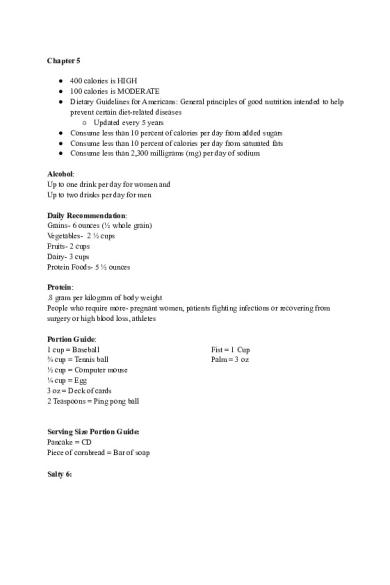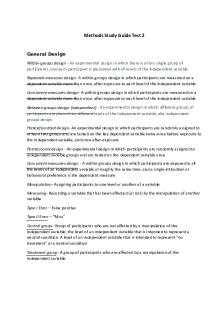Health Test 2 Study Guide PDF

| Title | Health Test 2 Study Guide |
|---|---|
| Course | Personal Wellness |
| Institution | James Madison University |
| Pages | 6 |
| File Size | 131 KB |
| File Type | |
| Total Downloads | 81 |
| Total Views | 153 |
Summary
Proedehl HTH 100 Study Guide...
Description
Chapter 5 ● 400 calories is HIGH ● 100 calories is MODERATE ● Dietary Guidelines for Americans: General principles of good nutrition intended to help prevent certain diet-related diseases ○ Updated every 5 years ● Consume less than 10 percent of calories per day from added sugars ● Consume less than 10 percent of calories per day from saturated fats ● Consume less than 2,300 milligrams (mg) per day of sodium Alcohol: Up to one drink per day for women and Up to two drinks per day for men Daily Recommendation: Grains- 6 ounces (½ whole grain) Vegetables- 2 ½ cups Fruits- 2 cups Dairy- 3 cups Protein Foods- 5 ½ ounces Protein: .8 gram per kilogram of body weight People who require more- pregnant women, patients fighting infections or recovering from surgery or high blood loss, athletes Portion Guide: 1 cup = Baseball ¾ cup = Tennis ball ½ cup = Computer mouse ¼ cup = Egg 3 oz = Deck of cards 2 Teaspoons = Ping pong ball
Serving Size Portion Guide: Pancake = CD Piece of cornbread = Bar of soap Salty 6:
Fist = 1 Cup Palm = 3 oz
1) 2) 3) 4) 5) 6)
Breads and Rolls Cold Cuts and Cured Meats Pizza Poultry Soup Sandwiches
Vegetarians: Health Issues: generally better ● Lower weight ● Lower disease risk-cancer, heart disease, digestive disorders ● Some vitamin and mineral deficiencies depending on type Chapter 7 ● ● ● ●
Around half of all adults meet the guidelines for aerobic activity (150 minutes/week) 30% of adults meet guidelines for strength training (2+ times per week) 20 % meet the guidelines for both aerobic and strength training guidelines 25-30% get NO activity
General Trend- People are exercising more now than before Muscular Strength- Most force you can make with one contraction Frequency- Number of times per week Intensity- How much effort and how hard Time- Duration of workout session Type- Mode of activity Ideal Amounts Per Week: Cardio- 3 to 5 days per week. 20 to 60 min. 64% to 96% max heart rate Muscular fitness- 2 to 3 days per week. 8-10 exercises of 2-4 sets of 8-12 reps. 60% to 80% of 1 rep max. Flexibility- At least 2 to 3 times per week. 10 to 30 seconds per stretch for 2 to 4 sets. To point of mild tension. Planning Fitness: Warm-up- light activity with stretching major muscle groups Workout- CV activity or Strength training or both Cool-down- light activity with stretching major muscle groups, heart rate below 100 Plan to increase duration or intensity by no more than 10% each week
Priorities when training: Better endurance- Cardio first Lose weight- Strength training Improve strength- Strength first Upper body strength- Either first Lower body strength- Strength first Cardio: Cardiovascular endurance- ability of the heart, lungs and blood vessels to deliver adequate amounts of O2 to meet the demands of prolonged physical activity Minimum- 150 minutes of moderate or 75 min of vigorous per week Talk-Sing Test- You should have enough air in your lungs to talk but not sing. Training heart rate (THR) % max ● Lower end for beginners or longer duration ● moderate 50-60% max (maximum = 220- age in years) ● Higher end for fit or shorter duration ● Vigorous 70-80% max or RPE: Rating of Perceived Exertion ● Scale of 1-10, feeling of effort or difficulty ● Moderate 5 or 6 ● Vigorous 7 or 8 ● Equate with target heart rate Flexibility: Definition: Range of motion at a joint Improves posture and movement efficiency Types of Muscle Activity: Isometric: force applied with no movement ● Isotonic: force applied with movement ● Concentric- muscle shortens (bicep curl - up) ● Eccentric - muscle lengthens (bicep curl -down) Injury Treatment: Rest Ice Compression Elevation
Support Chapter 6: Weight Management ● 2 out of 3 adults in the United States are overweight or obese ● 1 in 3 adults are obese ● About 1 in 13 adults have extreme obesity ● About 1 in 6 children were obese ● 300,000 deaths every year are related to obesity ● The prevalence in obesity has more than doubled in adults and tripled among children ● Obese babies have a higher chance of being obese due to fat cells ● Southern states have a higher obesity rate ● Men are obese if body fat percentage exceeds 25% of total body mass, women 32% ● Waist to hip ratio - men > 1.0 is greater risk, women > .8 ● 1 pound of fat is 3500 calories ● 147 billion $ annual cost to health care & lost productivity ○ Obese spend $1,500 more per yr in medical costs ○ 41% more than the average person ● An obese teenager has over a 70% greater risk of becoming an obese adult ● Overweight and obesity are both labels for ○ Ranges of weight that are greater than what is generally considered healthy for a given height. ○ also identify ranges of weight that have been shown to increase the likelihood of certain diseases and other health problems. ● Body Mass Index (BMI) ○ BMI of 18.8 - 24.9 is Healthy ○ BMI of 25 or above is Overweight ○ BMI of 30 or above is Obese ● Waist Measurements ○ Men: 40+ inches = greater risk ○ Women: 35+ inches = greater risks ● Of the top ten leading causes of death in the U.S., Four of them are related to diet ● Obese individuals have a mortality rate twice that of non-obese ● Health threats linked to obesity ○ Diabetes ○ Cardiovascular disease & hypertension ○ Gout ○ Gallstones ○ Sleep apnea ○ Certain cancers ■ men: colon, rectum and prostate ■ women: gallbladder, ovaries, uterine lining, and breasts
● More Health Issues ○ Musculoskeletal disorders: joints, back ○ Skin problems ○ Sterility ○ Accidents ○ Shorter life expectancy ○ Psychological: low self-esteem, depression, poor body image ○ Social: Discrimination
Chapter 5 Part 1 Calories per gram Carbs- 4 Protein- 4 Fat- 9 Alcohol- 7 Macronutrients Fat Protein Carbohydrates
30% 12% 58%
Micronutrients Vitamins (organic) Minerals (inorganic) 50-60% of our total body weight is water Triglycerides- saturated or unsaturated most common form of fat circulating in the blood 95 percent of body fat The liver converts excess calories into triglycerides. Sterols- cholesterol Phospholipids- High Density & Low Density HDL = High Density or Healthy or Helpful LDL = Low Density or Lousy Omega 3 and Omega 6 are good Glycemic index- rates the potential of foods to raise blood glucose levels. Foods that break down quickly have a high glycemic rating. Foods that digest slowly have a low glycemic rating.
Fat soluble Vitamin: A, D, E, K Water soluble: C and B The recommended intake of fiber for men is 38 grams per day Fruit is a simple carb Good source vitamin C- Citrus fruit, broccoli, cabbage Good source vitamin E- Yellow and green leafy vegetables, margarine...
Similar Free PDFs

Health Test 2 Study Guide
- 6 Pages

Test 2 Study Guide
- 7 Pages

Study Guide, Test 2
- 14 Pages

Study Guide Test 2
- 15 Pages

Unit 2 Test Study Guide
- 5 Pages

Philosophy Test 2 study guide
- 8 Pages

Psych Test #2 study guide
- 6 Pages

Methods study guide test 2
- 5 Pages

CHD4630 Study Guide Test 2
- 5 Pages

Anatomy Test 2 Study Guide
- 5 Pages

Biol101 Test 2 Study Guide
- 4 Pages

Patho Test 2 Study Guide
- 27 Pages

Lecture Test #2 Study Guide
- 11 Pages
Popular Institutions
- Tinajero National High School - Annex
- Politeknik Caltex Riau
- Yokohama City University
- SGT University
- University of Al-Qadisiyah
- Divine Word College of Vigan
- Techniek College Rotterdam
- Universidade de Santiago
- Universiti Teknologi MARA Cawangan Johor Kampus Pasir Gudang
- Poltekkes Kemenkes Yogyakarta
- Baguio City National High School
- Colegio san marcos
- preparatoria uno
- Centro de Bachillerato Tecnológico Industrial y de Servicios No. 107
- Dalian Maritime University
- Quang Trung Secondary School
- Colegio Tecnológico en Informática
- Corporación Regional de Educación Superior
- Grupo CEDVA
- Dar Al Uloom University
- Centro de Estudios Preuniversitarios de la Universidad Nacional de Ingeniería
- 上智大学
- Aakash International School, Nuna Majara
- San Felipe Neri Catholic School
- Kang Chiao International School - New Taipei City
- Misamis Occidental National High School
- Institución Educativa Escuela Normal Juan Ladrilleros
- Kolehiyo ng Pantukan
- Batanes State College
- Instituto Continental
- Sekolah Menengah Kejuruan Kesehatan Kaltara (Tarakan)
- Colegio de La Inmaculada Concepcion - Cebu


